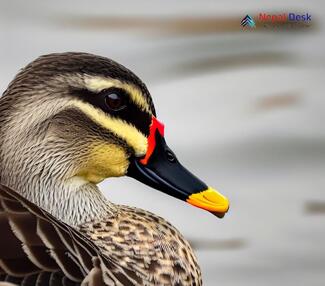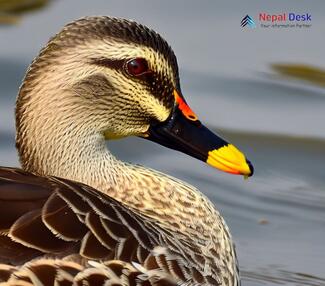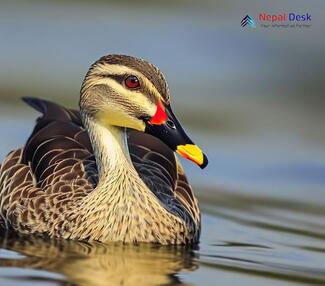The Indian spot-billed duck, scientifically known as Anas poecilorhyncha, is a familiar sight across the Indian subcontinent. Often found near freshwater lakes, ponds, and rivers, this beautiful bird is admired by birdwatchers and nature lovers alike. Let us explore the details of the Indian spot-billed duck and marvel at its presence in the picturesque landscapes of Nepal.
Physical Features
The Indian spot-billed duck is a medium-sized waterfowl, with a body length of 55-63 cm and a wingspan ranging from 90-95 cm. Sporting various shades of brown with a distinctive yellow-tipped black bill, this duck boasts a unique appearance. The male and female ducks are quite similar in their plumage; however, male ducks are characterized by a red-colored region at the base of their bill during the breeding season.
Habitat and Distribution
With their natural habitat spanning across South Asia—including Bangladesh, India, Pakistan, Myanmar, and Sri Lanka—the Indian spot-billed duck thrives in wetlands that provide adequate food and shelter. These adaptable birds can also be found in human-made water bodies such as reservoirs and ponds.
Nepal represents an essential part of the Indian spot-billed duck distribution range. The country's wetlands provide an ideal habitat for these birds to flourish; popular sites include Koshi Tappu Wildlife Reserve, Chitwan National Park, and Beeshazari Tal.
Behavior and Feeding Habits
The Indian spot-billed duck exhibits specific social behaviors, such as forming small groups during non-breeding seasons while becoming more territorial during breeding periods. Their diet mainly consists of plant material like seeds, roots, tubers, and leaves; however, they also feed on insects, mollusks, and worms.
Breeding and Nesting
The breeding season for the Indian spot-billed duck typically takes place between December and March. The female duck is responsible for constructing a nest usually on the ground, close to water bodies. After laying 6-12 eggs, the female will incubate them for 26-30 days. Once the ducklings hatch, they accompany their mother to feed in nearby water sources.
Conservation Status
Currently, the Indian spot-billed duck is listed as a species of "Least Concern" on the IUCN Red List. Nevertheless, the preservation of wetland habitats is crucial to ensuring the long-term survival of this species. The Ramsar Convention recognizes Nepal’s efforts to protect wetlands like Koshi Tappu Wildlife Reserve, which aids in securing a sustainable future for these beautiful ducks.
In conclusion, the Indian spot-billed duck is an intriguing waterfowl species that attracts avid birdwatchers and biologists alike. Preserving their natural habitats throughout South Asia, including Nepal's picturesque landscape, is essential for sustaining their population and allowing future generations to appreciate these graceful birds' beauty.




